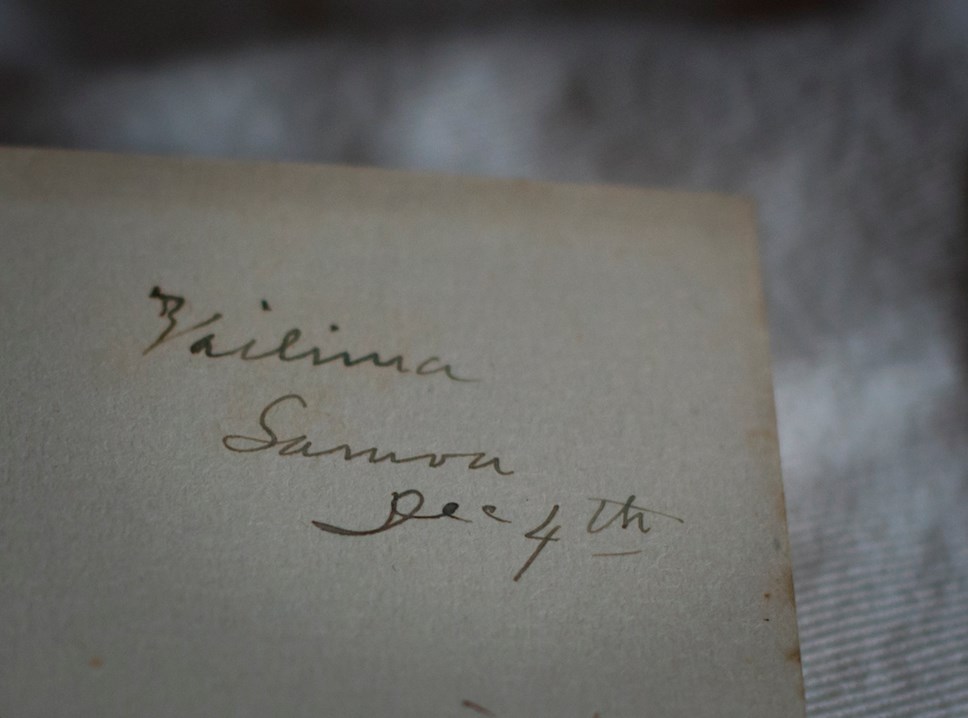
Letter tells of final hours of Robert Louis Stevenson
The final hours of writer Robert Louis Stevenson are detailed in a moving letter written by his grieving widow that has been obtained by the National Library of Scotland.
The letter from Fanny Stevenson to a friend was written the day after her husband collapsed and died from what is thought to have been a brain haemorrhage at their home in Samoa on December 3, 1894. He was only 44.
“His life had been one long romance and he hoped to have a romantic end; the artist in him demanded that completeness,” writes Fanny in her tight script on small notepaper. “To grow old he could not bear. He has had his wish and, for that, I try to be thankful, though all the rest of my life will be empty and lonely. True, I have my children but I have not Louis. No one knows what that means but me.”
She says she had been crushed by a sense of impending disaster for days before Stevenson’s death and he had sought to lighten her mood by playing cards. Then, together, they began to make mayonnaise for dinner. “I began to mix the mayonnaise; he dropping the oil with a steady hand, drop by drop. Suddenly, he set down the bottle, knelt by the table, leaning his head against it. I cannot go on just now.
It was the hand of death that had stricken him down. In less than five minutes he was profoundly insensible and so remained till the end. It was about six when he knelt at the table and at ten minutes after eight, he passed away. In a very short time, we had two doctors and a medical missionary here but there was nothing to do.”
The letter is one of a series sent by Fanny and her husband to Anne Jenkin, the wife of Stevenson’s former Edinburgh University tutor and professor of engineering, Fleeming Jenkin. The letters, together with an incomplete manuscript of an essay, telegrams, photographs and newspaper cuttings, were bought by the Library at auction. They add to the Library’s existing rich collection of Stevenson material which includes important papers about his early life in Edinburgh, his development as a writer and his time in Samoa.
Details of the latest acquisition, which was bought with the support of the Soutar Trust and the Friends of the National Libraries, are being released as the anniversary of Stevenson’s death approaches. National Librarian Dr John Scally said: “It is pleasing that these letters relating to one of Scotland’s greatest ever writers are part of the collection in the city and the country of his birth. They are sure to be of interest to scholars and the wider public and we are delighted to have acquired them.”
Fanny’s letter also describes the devotion of native Samoans to her husband, who was known to them as Tusitala – story teller. Stevenson’s wish was to be buried at the top of Mount Vaea which overlooked his home on Samoa. That involved 40 Samoans labouring for hours to cut a path through the bush to the ancient burial place of chiefs.
There, his grave was dug and a makeshift tinsel cross was placed at its head. “Nothing that money could buy would have pleased Louis more or more clearly touched his heart than that little tinsel cross,” she adds.
Stevenson had been dogged by ill health for most of his life and lived in many places to try to find a climate best suited to his health. He had no expectation of a long life. “I try to remember how he had hoped to go like this,” Fanny writes. “That very day he had said to me ‘the thought of dying in bed is horrible to me; I want to die like a clean human being on my feet. I want to die in my clothes, to fall just as I stand.’ He did. It was only at the very end, for the last few breaths, that we laid him down.”
Ends
For further information contact Stewart Hardy on 0131 623 3739
Notes to Editors
National Library of Scotland
The National Library of Scotland is a major European research library and one of the world’s leading centres for the study of Scotland and the Scots - an information treasure trove for Scotland’s knowledge, history and culture.
The Library’s collections are of world-class importance. Key areas include digital material, rare books, manuscripts, maps, music, moving images, official publications, business information, science and technology, and the modern and foreign collections. The Library holds more than 25 million items dating back over 1000 years. This includes over four million books, eight million manuscripts, two million maps and over 45,000 films and videos. Every week it collects around 4,000 new items. Around 80% of these are received free of charge in terms of Legal Deposit legislation. Further information is available at www.nls.uk
